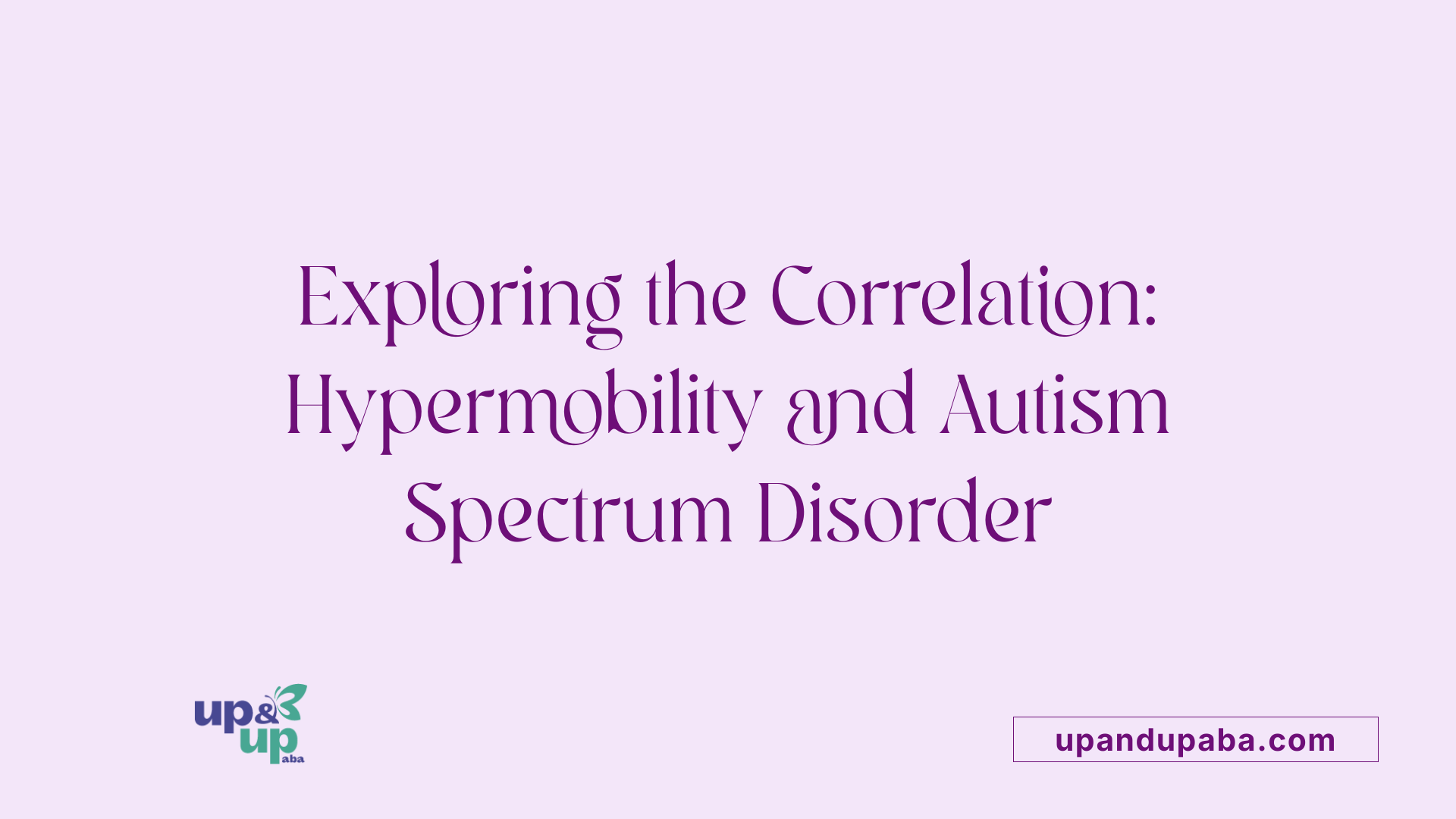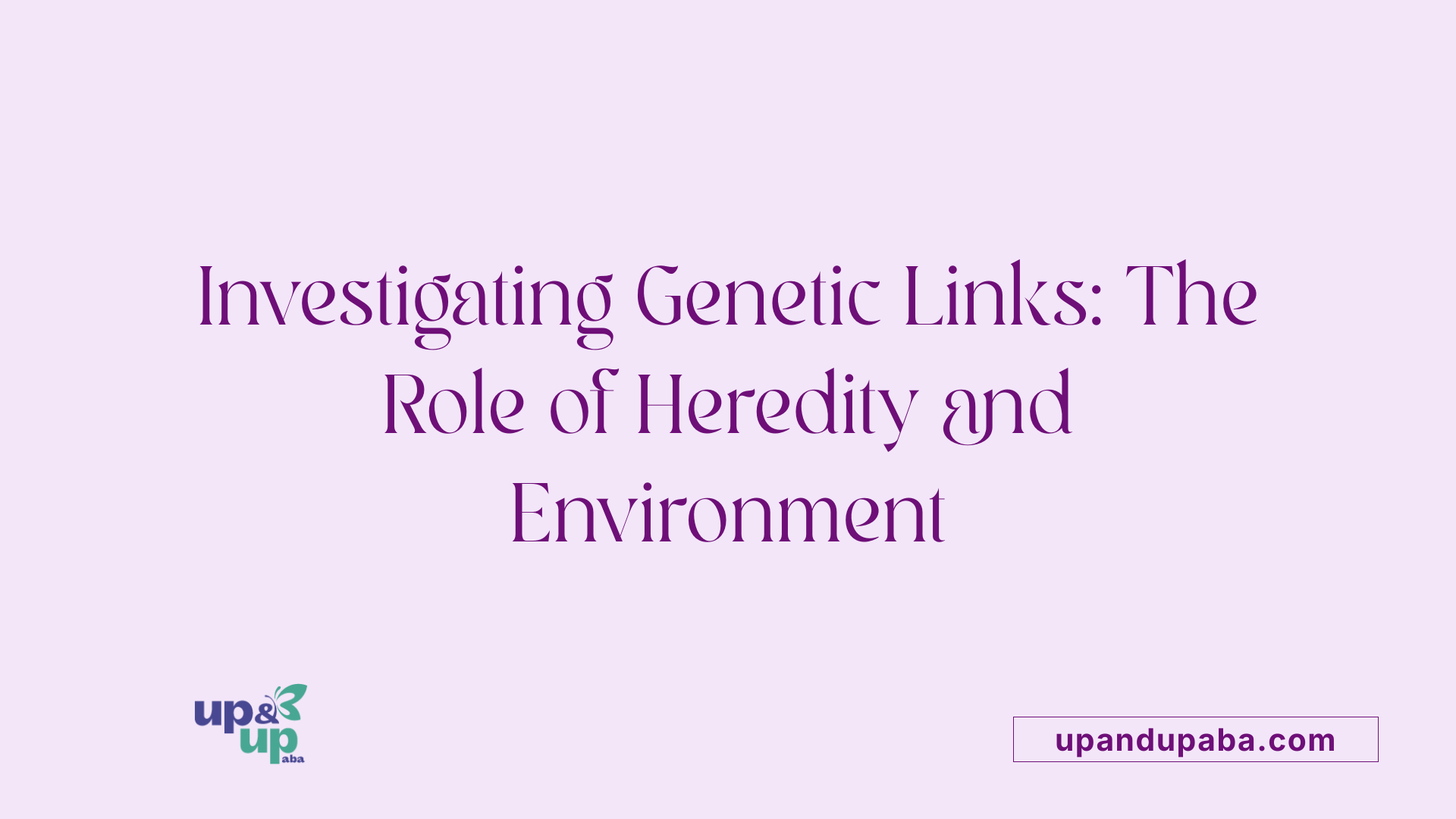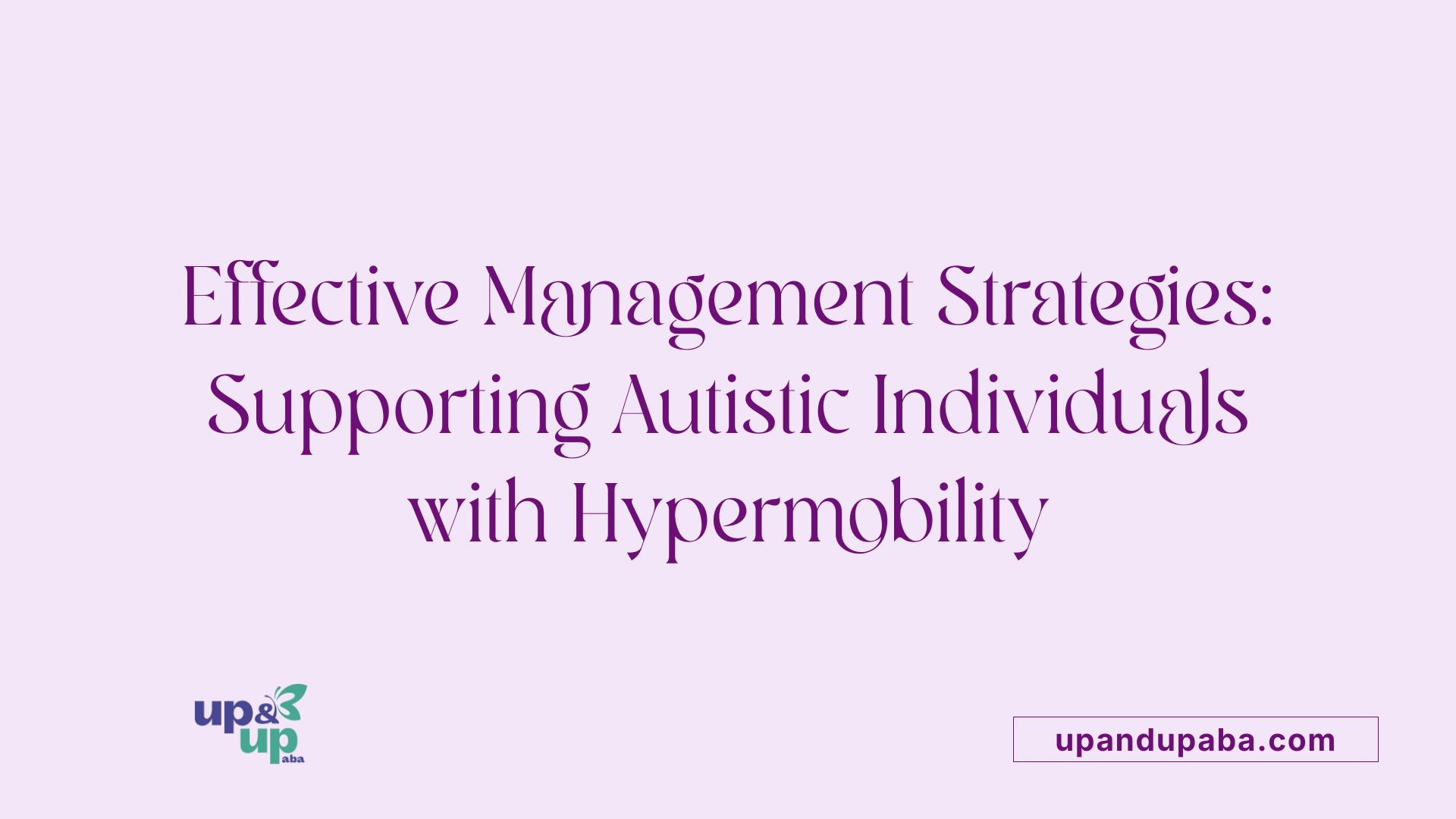Hypermobility and Autism
Exploring the Intersection of Joint Hypermobility and Autism Spectrum Disorder

Introduction to Hypermobility in Autism
Autistic individuals are increasingly recognized for having overlapping conditions, one of the most prominent being joint hypermobility. Understanding the nuances of this relationship offers insights into their interconnectedness, potential common etiologies, and tailored management strategies that can improve quality of life.
Defining Hypermobility and its Diagnostic Criteria

Understanding hypermobility
Hypermobility refers to an increased range of motion in the joints. This condition can cause joints to move beyond their normal range, leading to potential issues like joint instability and chronic pain. It is often documented as part of several connective tissue disorders, collectively known as Hypermobility Spectrum Disorders (HSD).
What is hypermobility spectrum disorder (HSD)?
Hypermobility spectrum disorder (HSD) encompasses a range of connective tissue disorders characterized by joint hypermobility, instability, and chronic pain, along with additional symptoms such as fatigue and headaches. Individuals with HSD have joints that can move beyond normal ranges, which can lead to injuries like dislocations and sprains.
Diagnostic criteria and tools
Diagnosis generally involves a comprehensive medical history review and physical examinations. Tools such as the Beighton score are utilized to determine the extent of hypermobility. A total score of 4 or greater typically indicates joint laxity. It’s essential to differentiate HSD from other related conditions during diagnosis to ensure appropriate management.
Prevalence in autism
Recent studies indicate that joint hypermobility is more prevalent among individuals with Autism Spectrum Disorder (ASD). Research shows that over 50% of individuals diagnosed with autism also exhibit hypermobility, contrasting with 20% observed in the general population. This points to a significant correlation between these two conditions, suggesting that healthcare providers should be aware of the overlap to facilitate better diagnostic assessments and treatment strategies.
| Criterion | Description | Importance |
|---|---|---|
| Beighton Score | A scoring system used to assess hypermobility | Diagnoses HSD effectively |
| Medical History | Review of joint issues and family history | Identifies hereditary connections |
| Physical Examination | Hands-on evaluation of joint movements | Confirms hypermobility presence |
| Sensory Processing Assessment | Evaluates sensory-related challenges | Links sensory issues to hypermobility |
Understanding the connection between hypermobility and autism is crucial for effective management and support for those affected.
Prevalence of Joint Hypermobility in Autistic Individuals

Is there a link between hypermobility and autism?
Research indicates a significant relationship between hypermobility and autism spectrum disorder (ASD). Approximately 50% of individuals diagnosed with ASD also exhibit joint hypermobility, a stark contrast to the 20% prevalence found in the general population. Notable studies, including those led by Casanova et al. (2020), demonstrate that autistic individuals often report higher rates of hypermobile joints compared to neurotypical peers, particularly in the context of conditions such as Ehlers-Danlos syndrome (EDS).
Gender differences in hypermobility prevalence
Gender also plays a role in the prevalence of hypermobility. Studies show that women with ASD have a significantly higher occurrence of generalized joint hypermobility (GJH), with rates reaching 44.7% compared to 21.6% in men. This gender discrepancy is important as it may inform clinical assessments and tailored treatment approaches for autistic individuals, particularly concerning physical therapy and pain management.
Hereditary factors
The hereditary nature of hypermobility is evidenced by findings that mothers with EDS or hypermobility spectrum disorders often have autistic children. This genetic link suggests that familial patterns may contribute to the higher rates of ASD among individuals with hypermobile joints. Moreover, the exploration of genetic and environmental factors continues to shed light on the biological underpinnings of the association between hypermobility and autism, emphasizing the need for comprehensive diagnostic frameworks.
| Aspect | Prevalence in Autistic Individuals | General Population | Notable Findings |
|---|---|---|---|
| Joint Hypermobility | ~50% | ~20% | Higher occurrence noted often linked with neurodevelopmental disorders like ASD. |
| Gender Comparisons (Women) | 44.7% | N/A | Women show a significantly higher prevalence compared to men in the context of ASD. |
| Hereditary Link to Autism | Increased incidence | N/A | Familial trends observed, particularly in mothers with EDS having autistic offspring. |
Genetic and Environmental Contributions

Genetic links between hypermobility and autism
Research has highlighted significant genetic connections between hypermobility and autism. Specifically, individuals diagnosed with Autism Spectrum Disorder (ASD) are statistically more likely to have joint hypermobility. Studies indicate that up to 80% of Autistic individuals may experience hypermobility, a stark contrast to approximately 20% in the general population. A notable study led by Dr. Emily L. Casanova demonstrated that over 20% of mothers with Ehlers-Danlos syndrome (EDS) or hypermobility spectrum disorders had Autistic children, suggesting a hereditary link that warrants further examination.
Family studies and hereditary connections
Family studies provide compelling evidence for the genetic predisposition to hypermobility, particularly in the context of EDS. Among children with Ehlers-Danlos syndrome, about 6% show signs of autism; this prevalence is notably higher than the estimated 2.6% autism prevalence in the general population. Such findings underscore the significant overlap between these hereditary conditions and highlight the need for awareness in clinical assessment and treatment strategies.
Mothers' health impact on children
The health and immune status of mothers may also play a crucial role in the likelihood of autism in their children, particularly those with connective tissue disorders. Research indicates that the severity of a mother’s immune disorder correlates with the risk of autism in her children, further emphasizing the complex interplay of genetic and environmental factors within families. Identifying these influences is critical for developing tailored interventions that support both mothers and their neurodivergent children.
Additional Insights on Hypermobile Neurodivergent Individuals
Individuals classified as neurodivergent, particularly those with ASD, ADHD, or Tourette syndrome, are more than twice as likely to exhibit hypermobility compared to their neurotypical peers. Furthermore, chronic pain, often symptomatic of hypermobility, is reported significantly more frequently in these populations. This data, compiled from research at Brighton & Sussex Medical School, illustrates the importance of cross-disciplinary approaches that encompass both neurodevelopmental and physical health concerns.
Ehlers-Danlos Syndrome and Its Correlation with Autism

Understanding EDS Types
Ehlers-Danlos syndrome (EDS) is characterized by a group of inherited conditions that predominantly affect the body's connective tissue. There are 13 recognized types of EDS, each defined by unique features and genetic underpinnings. The hypermobile EDS (hEDS) subtype is notably prevalent, comprising 80-90% of EDS cases and affecting approximately 1 in every 3,100 to 5,000 individuals. Diagnosis often relies on a combination of medical history, physical examination, and assessment of joint flexibility.
hEDS Prevalence and Features
Research indicates that hEDS is particularly common among autistic individuals, potentially due to overlapping genetic and physiological characteristics. It has been estimated that individuals with EDS are 7.4 times more likely to be diagnosed with autism than the general population. Notably, many individuals with EDS experience chronic pain, fatigue, and an increased risk of joint injuries, complicating their clinical presentations further.
Common Symptoms with Autism
Both autism and hEDS share several overlapping symptoms, including motor difficulties, sensory processing issues, and autonomic nervous system dysfunction. Autistic individuals may also exhibit challenges like joint hypermobility, which can lead to clumsiness and balance issues. The increased incidence of symptoms such as proprioceptive dysfunction and anxiety in individuals with both conditions highlights the need for awareness and tailored management approaches in clinical settings.
| Aspect | Ehlers-Danlos Syndrome (EDS) | Autism Spectrum Disorder (ASD) |
|---|---|---|
| Type | Hypermobile EDS (hEDS) | Notable prevalence of ADHD, learning disorders, etc. |
| Prevalence | Higher among individuals with autism | Estimated 2.6% in general population |
| Common Symptoms | Joint hypermobility, chronic pain, fatigue | Motor difficulties, hypersensitivity |
| Management Approach | Physical therapies, pain management | Tailored strategies, occupational therapies |
Understanding the relationship between hEDS and autism is critical for appropriate diagnosis and intervention strategies to improve the quality of life for affected individuals.
Clinical Challenges and Overlapping Symptoms
Diagnostic Challenges
Diagnosing joint hypermobility in individuals with Autism Spectrum Disorder (ASD) presents significant challenges for healthcare professionals. The overlapping symptoms of both conditions—such as chronic pain and motor difficulties—often lead to misdiagnosis or overlooked signs. Joint Hypermobility (JH) is frequently mistaken for typical behaviors associated with autism, thus complicating proper evaluation and treatment strategies. Additionally, inappropriate assessment techniques can exacerbate the difficulty of distinguishing JH from other coexisting conditions.
Overlapping Symptoms with Autism
Many symptoms commonly associated with hypermobility resonate closely with those of autism. For example, individuals with both conditions frequently experience:
- Sensory Processing Issues: Both hypermobility and autism can result in heightened sensory sensitivities.
- Motor Coordination Difficulties: Clumsiness or challenges with balance can be prevalent in both groups.
- Chronic Pain: Autistic individuals often underreport pain, further complicating diagnosis, particularly when joint hypermobility is present.
Potential Misdiagnoses
The intersection of symptoms between hypermobility and autism may lead to significant misdiagnoses. Pain and joint instability experienced by hypermobile individuals might be interpreted solely as behavioral issues linked to autism. Such diagnosis inaccuracies can hinder effective treatment approaches, emphasizing the importance of thorough evaluations that consider co-occurring disorders to enhance patient care.
What is the difference between hypermobility and hyperflexibility?
Hypermobility and hyperflexibility are terms that describe different aspects of musculoskeletal function. Hyperflexibility refers to the ability of muscles to stretch and return to their original length, akin to a rubber band, without increasing the risk of joint injury. In contrast, hypermobility is characterized by laxity in the ligaments around a joint, which can lead to excessive movement and potential instability, increasing the risk of pain and injury. While hyperflexible individuals may not face an injury risk, those with hypermobility often require strengthening exercises to support their joints effectively. Conditions such as Ehlers-Danlos Syndrome may be associated with hypermobility, emphasizing the need for muscle stabilization to improve joint function and reduce discomfort.
Sensory Processing and its Role in Hypermobility
Link between sensory processing issues and hypermobility
Hypermobility and sensory processing difficulties have a notable connection, particularly in autistic individuals. Imbalances in sensory input processing can lead to over-flexible joints due to the way nervous system functions affect muscle control and tissue properties. This connection suggests that improper sensory integration may contribute to increased symptoms of hypermobility.
Impact on motor control and coordination
The interplay between sensory processing and hypermobility often impacts motor control and coordination in autistic individuals. For instance, those with hypermobility may experience difficulties with balance and coordination, leading to frequent injuries and chronic pain. Additionally, patterns of joint laxity can complicate movement strategies, ultimately affecting physical performance and everyday activities.
Potential therapies
Addressing hypermobility within autistic patients often calls for a multi-faceted therapeutic approach. Effective management strategies may include:
- Physiotherapy: Targeting muscle stability and strength to support hypermobile joints.
- Occupational Therapy: Helping individuals adjust to daily tasks while accommodating their physical limitations and sensory sensitivities.
- Assistive Devices: Utilizing tools like braces or other supports to enhance joint stability and reduce discomfort.
How is hypermobility related to ADHD and sensory issues?
Hypermobility is significantly associated with attention deficit hyperactivity disorder (ADHD) and sensory issues, often appearing together in individuals. Studies have shown that adults with ADHD are more likely to exhibit joint hypermobility, with one study indicating a 6.9 times greater likelihood of symptomatic generalized joint hypermobility (GJH). Genetic factors appear to link these conditions, suggesting that they share a common hereditary basis. Additionally, individuals with ADHD and hypermobility frequently report higher levels of physical symptoms like pain and dysautonomia, which can complicate the management of ADHD symptoms. Future research is needed to further understand the mechanisms linking hypermobility, ADHD, and sensory processing issues.
Managing Hypermobility Challenges in Autism

How are hypermobility challenges managed in autistic individuals?
Hypermobility challenges in autistic individuals are managed through various therapeutic approaches aimed at alleviating symptoms and improving quality of life. A significant part of this management involves physical therapy and occupational therapy, designed specifically to enhance joint stability and muscle strength.
- Physical Therapy: Programs focus on targeted exercises to strengthen muscles and increase stability around hypermobile joints. This can help prevent injuries and reduce fatigue caused by joint laxity.
- Occupational Therapy: This therapy aids in developing strategies to improve daily functionalities, such as improving motor skills and enhancing coordination through focused activities.
- Assistive Devices: Tools like braces or splints are commonly used to provide additional support to joints, reducing pain and instability during movement.
Diagnosis typically involves a thorough medical evaluation, including standardized assessments such as the Beighton score to evaluate the degree of hypermobility experienced.
What daily management strategies are recommended?
Daily management strategies also play a crucial role in handling hypermobility in autistic individuals. These can include:
- Tailored Exercise Programs: Regular, structured activities that promote flexibility without overexertion can maintain joint function without exacerbating pain.
- Pain Management Techniques: Thermal therapies, like heat or ice, can relieve joint discomfort associated with hypermobility.
- Routine Monitoring: Continuous assessment of joint stability and muscle performance helps adapt strategies accordingly.
How should families coordinate with healthcare professionals?
Coordinating with healthcare professionals is essential for comprehensive management:
- Multidisciplinary Care: Involving a team of specialists, including physiotherapists, occupational therapists, and behavior analysts, ensures a holistic approach tailored to the individual needs of the autistic person.
- Education and Support: Families should advocate for regular screenings and assessments to identify and respond to hypermobility symptoms promptly. Education about hypermobility’s impact can facilitate better care strategies and awareness across all healthcare interactions.
Recognizing and treating hypermobility in autistic individuals is crucial, as it can significantly influence their daily activities and overall well-being.
Research Insights and Future Directions
Current Research Findings
Recent studies have established a significant correlation between hypermobility and Autism Spectrum Disorder (ASD). It has been found that over 80% of autistic individuals may experience joint hypermobility, a statistic that starkly contrasts with the 20% prevalence in the general population. Research indicates that symptomatic generalized joint hypermobility (GJH) shows even higher rates among neurodivergent individuals, especially females, raising the need for integrated awareness in clinical settings.
Future Research Areas
Ongoing exploratory studies are focusing on the potential overlapping mechanisms between hypermobility and ASD. This includes delving deeper into genetic links seen in families with both hypermobility spectrum disorders and autism. Future investigations aim to highlight the role of sensory processing issues and how they relate to joint dysfunction.
Potential for Improved Diagnostics
The diagnostic challenge is clear: symptoms of hypermobility often overlap with those of autism. Improving diagnostic protocols will enhance recognition of hypermobility-related disorders in autistic individuals, leading to better management strategies. This could include tailored physiotherapy or assistive devices effective for both conditions. Researchers advocate for routine screenings in children with joint hypermobility to detect neurodevelopmental symptoms early, thus paving the way for more comprehensive care.
Understanding the Impact on Daily Life and Well-being
Quality of life challenges
Individuals with hypermobility, especially those on the autism spectrum, often face significant quality of life challenges. Physical symptoms like chronic pain and joint instability can compromise their ability to engage in everyday activities. Tasks that require fine motor skills or physical coordination may be particularly difficult, leading to frustration and decreased participation in school, work, and social interactions.
Potential societal impacts
The societal impacts can be profound as well. Autistic individuals with hypermobility may struggle in environments that are not accommodating. This can lead to greater reliance on support services and caregivers, influencing socioeconomic status and community integration. Awareness of these challenges is crucial for fostering inclusive environments that acknowledge the needs of these individuals.
Advocacy for improved care
Advocacy for improved care and support is essential. Healthcare professionals should be trained to recognize the signs of hypermobility in autistic individuals, offering comprehensive management strategies. Encouraging open communication between various disciplines can lead to better outcomes and improved quality of life for those affected.
Concluding Thoughts on Hypermobility and Autism
The relationship between hypermobility and autism highlights a complex interplay of genetic, physiological, and sensory factors. As medical professionals and researchers advance their understanding, the emphasis on an integrated approach to diagnosis, management, and treatment reflects the necessity of considering both physical and neurological aspects in autistic individuals with hypermobility. This comprehensive approach can significantly improve care strategies and enhance the quality of life for those navigating these intertwined conditions.
References
- The Link Between Hypermobility and Autism: Symptoms and ...
- The Relationship Between Generalised Joint Hypermobility and ...
- Is Hypermobility Linked to Autism? - The Fibro Guy
- Is Joint Hypermobility a Sign of Autism? - Healthline
- Relationship and New Prospectives in Joint Hypermobility in ...
- Bendy joints, stretchy skin, clumsiness. Why hypermobile Ehlers ...
- Other conditions that affect autistic people - NHS



